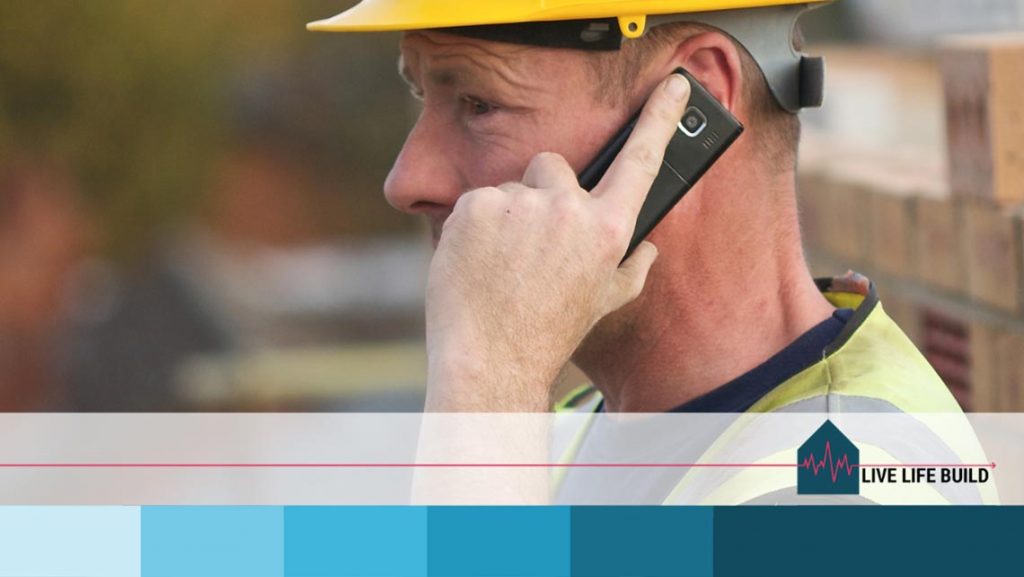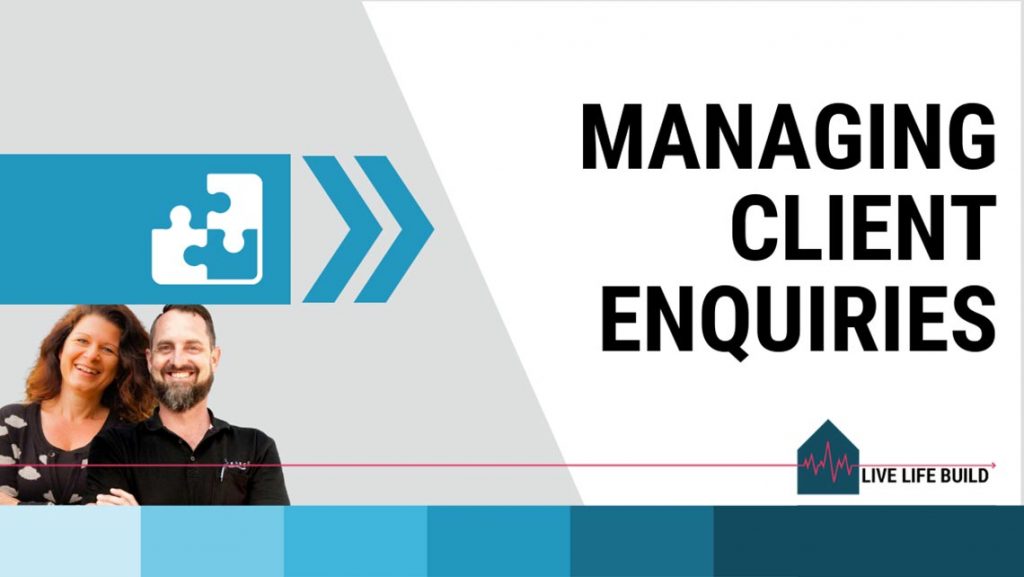Do you have a process for managing client enquiries?
Read this to learn the 5 steps for managing client enquiries as a professional builder.
Client enquiries are the first gateway in a potential client making contact with you, and understanding more about who you are and the way you do business.
If you don’t have a process for managing your client enquiries, you can find that your initial contact with a potential client ends up being less impressive than it could be.
Especially if it’s your mobile number they’re calling, and they catch you in the middle of something on site, or on the road between projects.
Or worse still, at home in the evening.
By creating a process to manage your client enquiries, it will help you save time in your business, ensure you’re giving the best possible attention to the enquiries that are good leads, and creating a great first impression from the outset.
And when you have a clear process that you can guide potential clients through from the start, you’ll be perceived as more professional, and they’ll feel more comfortable and confident with how you work.
Let’s look at the 5 steps for managing client enquiries.
5. SEPARATE ENQUIRY FROM ‘PICKING YOUR BRAIN’
One of the biggest challenges builders face when dealing with client enquiries is how much time they can tie up.
And, that the time it takes up is not necessarily productive time (for the potential client or the builder) in getting a project started well, or setting up a good relationship between you and the client.
This is because potential clients will often get a builder around to their home as a first starting point in their project planning. And then they’ll spend the entire time they’re with the builder, picking their brain about what might be possible, what things might cost, and what opportunities they have for their project.
Homeowners forget that they’re supposed to be interviewing a builder as a potential team member on their project team.
And builders forget they’re supposed to be marketing who they are, and what they’re like to work with … and instead offer a lot of suggestions and ideas that can create more confusion and overwhelm for the homeowner.
Homeowners can also be contacting builders when they’re still years away from getting serious about their projects.
Or they can have a lack of knowledge that means they have unrealistic expectations regarding what’s possible, the timeframes, and the costs involved.
If you, as a builder, are dealing with all of this at the point of meeting a potential client for the first time, you could be wasting your time, and actually doing them a disservice too.
When homeowners use builders as a means of sourcing free information and guidance on what they can and can’t do with their home, it can mean they:
- Don’t value the free advice they receive (even though it might be amazing advice)
- Don’t get a full, comprehensive understanding of the process involved in their project
- May access incorrect information about local planning legislation and their approval pathway
- Not get to know you and what you’re like to work with (and whether you’re the right builder for them), because they’ll be assessing you based on the free information you’re willing to give
- May get even further away from starting their project because it sounds too overwhelming or expensive to undertake
So, when you have a process for managing client enquiries, you can guide any potential clients through a process that is more informative, helps them get to know you and your business better, educates them about what it’s like to work with you, and save you a lot of time with clients that are simply not ready to move forward with their project.

4. HOW DO POTENTIAL CLIENTS GET IN TOUCH WITH YOU?
Many builders drive around a work vehicle that has their mobile number on the side of it, or they have their mobile number on their website.
This means that any potential clients can call them directly as a starting point for their project.
And this can be a terrible starting point in a client relationship, for several reasons:
- They may interrupt you in the middle of another client’s project, and not get your full attention or the best experience of talking with you
- You may be driving and unable to jot down their contact details or gather any meaningful information that enables you to take the best next steps
- They may leave a message that then requires administration from you to get back in touch, and remind them of who you are (because they may have called several builders when they were calling you
- They can call you out of business hours, and interrupt your time with your family or your downtime, and again, not get the best experience of talking to you
And, when you’re receiving enquiry calls on your mobile phone, it’s incredibly disruptive to your everyday work, and the service you’re providing to your existing clients.
Yet, this seems to be a really common way that builders enable their potential clients to reach them, and make their initial enquiry.
If you’re a builder with an admin team, then it makes sense to ensure your client enquiry calls go directly to them. That way, you can create a system and process to deal with those client enquiries that is professional, and helps clients have a good impression of you from the outset.
Some builders who don’t have admin teams will use an answering service, or provide an email address instead.
However, that can often simply delay the problem, because then you have a list of names and numbers that you have to follow up and return calls to. Builders can find themselves returning those calls after hours, or playing phone tag with potential clients (who end up returning the calls on the builder’s mobile number anyway).
We also find that many homeowners are sending DMs (direct messages) to potential builders on their social media. This can be even more challenging, because they can end up in your ‘other’ folder. Or, you can again overlook replying, making it difficult to remember who to follow up later.
And, starting up a conversation on social media DMs is not necessarily the most professional way to kick off a relationship with a potential client.
Instead, create a clear pathway for potential clients to get in touch with you, that you can send all enquiries to (regardless of whether they call you, email you, or direct message you on social media).
What we teach our builder members is to create an enquiry form that potential clients have to complete to take the next steps with the builder (which, ideally, involves initiating the PAC Process).
When you create an enquiry form, you can then have a place to send all enquiries too. It will help you get important details from them, including their name, contact details and project address.
Plus, there’s more information you can collect from them that will enable you to vett the tyre-kickers from the potential clients that are a good fit for your business (check the next point for more information on that).
You can set up these forms using a range of online free tools, or simply create a Google Doc that you send out a link to. And then you can have the link in your notes on your phone with a standard message that you can then easily send to anyone who needs it (plus you can have it on your website and in your emails too).

3. GATHER INFORMATION FROM THEM AT THE OUTSET
One thing to remember is that not every enquiry you receive will be a viable project, a suitable client, or a worthwhile investment of your time and energy.
And so, it’s essential that your process for collecting client enquiries includes gathering information from them at the outset.
If you’re using an online enquiry form as part of your client enquiry process, then you can include a range of questions that will help you find out more information about the potential client plans.
It’s up to you what type of information you wish to collect. We have builder members who ask a few simple questions, right through to gathering a lot more detailed information in their enquiries right at the start.
It really depends on your business, the types of clients you work with, and what sets you up for success in taking next steps with these enquiries.
What type of information should you gather?
Well, let’s take you through why it’s important to find out more, and from that, you should be able to see the kinds of questions you can ask potential clients in an enquiry form.
Why is it important to find out more information about the potential client and their project plans?
There’s a range of reasons why it’s great to find out more information at this early stage, including:
- You can see if their project type is a good fit for your business model
- You can understand what stage they’re at, which guides the type of advice you can offer
- It will help you see if their timeline fits your current workload
- You’ll get an understanding of how realistic their budget is for the work they’re planning
- You can also understand where they heard about you, so you can see what marketing efforts are working better than others
One of the benefits of having an online enquiry process is that you can change and edit your questions over time, as you learn and improve this process.
You’ll be amazed at how much better you know your potential clients before making the next steps in contacting them, and how much that can improve the quality of your conversation.
Plus, you’ll quickly learn who is simply tyre-kicking (and sending their drawings to ten builders for pricing) vs who is someone you want to nurture a working relationship with and help.

2. AUTOMATE THIS PROCESS
One of the best things about having a client enquiry process that includes an online enquiry form, is that you can automate the process of receiving and registering client enquiries.
And you can then have a process to assess those enquiry forms and be able to streamline the process of getting in touch with potential clients, and taking the next best steps.
In addition, you’ll find that by doing this, and automating it, you’ll free up so much of your time for better things – such as taking care of your existing clients, and making much better connections with the potential clients you really want to work with.
We do get questions about automating this process and making your potential clients complete an enquiry form. So, let’s answer some of those.
What if they don’t want to answer?
In our experience, people who have done their research on you, are serious about their project, and who want to make progress on it, will complete an enquiry form. And in fact, a lot actually welcome the opportunity to tell you more about themselves and their project, so they don’t have to do all of that on the phone when they speak to you.
What if they don’t answer all the questions?
That can happen. However, we suggest that you include an introduction in your enquiry form that explains why you’re asking these questions and why it’s important that they complete them. A reason can include that it enables you to help them better.
What if they won’t tell me their budget?
Homeowners can be cagey about this, largely because they think that once they tell you their budget, you’ll simply use that information as the price you’ll tell them their project will cost!
However, again, it’s important to explain with some introductory information in the enquiry form, as to why budget is a useful piece of information. You can also have them simply supply a range, rather than an exact budget, so they can be more approximate with their answer.
You’ll be amazed at what you learn about potential clients when you start gathering this information.
And, you can then also use this information in how you educate potential clients in your early dealings with them, in the way you create your marketing material, and even the type of words and language you use to speak to your potential clients with.

1. KEEP FOLLOWING UP
Lastly, it’s really important that once you receive an enquiry from a potential client, that you have a follow up process in place.
If you’re using the PAC Process, there’ll be specific next steps to take with the potential client to get them to understand what’s involved, and see if they want to work with you in this way. We teach those steps inside our PAC Challenge.
However, if you’re still working traditionally with clients and doing tenders, then it’s important to have a process of how you follow up, so you can respond to them in the best way possible.
Remember, that each contact a potential client has with you is an opportunity to demonstrate your professionalism and your expertise, so treat the follow up similarly.
It can be useful in your business operations to have dedicated times that you’re in the office, and can then work through all your calls so you’re not distracted by other activities.
Or, you might want to schedule a time to get in touch with the client over email, etc, so you know they’ll be available to speak with you.
Whatever it is, let the potential client know when they can expect to hear from you. So many homeowners really struggle with the fact they get in touch with builders, and don’t know how long to wait before they can dismiss them or assume they’re too busy.
So, at the bottom of your enquiry form, let the person completing it know that they can hear from you in the next 48 hours – or whatever you can commit to.
If you are too busy to take on new work, or the project is not a good fit for you, then still pay them the courtesy of following up to let them know. This is how a professional builder operates.
And, then if you don’t hear from them, keep following them up. If you speak with them on the phone, and then don’t hear from them, then keep following them up. If you go to their house and meet with them, and then don’t hear from them, then keep following them up.
There’s a statistic that many people that says: 80% of sales require 5 follow-up calls after the meeting. 44% of sales reps give up after 1 follow-up.
(source: https://blog.thebrevetgroup.com/21-mind-blowing-sales-stats)
People are busy, and their lives are full. Their project can take a back seat to their regular, everyday demands. And they can simply forget to call you back, or only remember when it’s after hours or on the weekends.
Follow up, and keep following up, until you get a ‘No’.
(And, if you use a CRM email system, you can automate this follow-up process and use it to educate your potential client, share more about your business, stay front-of-mind with them, and share testimonials as well. We have a ‘365 Day Follow-Up’ template inside that we give to our builder members that’s perfect for this).
So, here’s our 5, 4, 3, 2, 1 to identify your ideal project.
5. Have you asked your team what their goals are?
4. How can you help and facilitate your team’s goals?
3. What are your goals as a team?
2. Holding people accountable.
1. Celebrate the wins and create a good work environment.
Live Life Build’s 6P Methodology unlocks the 6 ways to elevate your building business:
PERSONAL | PROJECTS | PEOPLE | PARTNERSHIPS | PROCESSES | PROFESSIONAL
Do you have a process for managing your client enquiries?

